With all of the recent cold weather, I’ve noticed a huge increase in traffic on one of my older blog posts on how to keep outside faucets from freezing. I have a few more tips to add, so I’m re-blogging this post.
Most homeowners in Minnesota know it’s important to ‘winterize’ the outside faucets to prevent them from freezing, because freeze damage can destroy the faucet or lead to a burst pipe. The problem is that many people don’t quite get it right; winterizing the outside faucets in the fall seems like a simple thing to do, and it seems like it should be straightforward and easy, but there are a few tricks you need to know to really get it right.
Garden hoses – First and foremost, disconnect the garden hose from the outside faucet. If you leave your garden hose attached to the faucet, you’re asking for trouble.
Determine if your faucet is frost-free or not. A rule of thumb is that if the faucet has a knob that’s perpendicular to the house, it’s frost-free. The knob turns a long stem that closes a valve inside the house where it’s warm. If the knob is at a 45 degree angle, it’s not frost free, and it needs to be winterized. This is only a rule of thumb though; if a boiler drain is installed at the exterior of the home, it will have a knob that’s perpendicular to the house, just like a frost free faucet, but it won’t be frost free. The photo below shows an example of a boiler drain installed at the exterior of a house.
To know for sure whether a faucet is frost-free or not, look up inside the spout. On a frost-free faucet, all you’ll be able to see is a metal stem. On a faucet that isn’t frost free, you’ll be able to see the valve components open and close when the handle is turned. The images below show a faucet that is not frost-free.
Post update 10/2018: Please ignore the advice above. The Woodford model 101 faucet is not a frost-free faucet, yet it’s completely indistinguishable from other frost-free faucets, save for the model number. Awesome.
Frost-free sillcocks with an integral vacuum breaker A properly installed frost-free sillcock with an integral vacuum breaker can have the water left on year ’round without any problems. A properly installed frost-free sillcock will have a slight downward pitch; this allows water to drain out when the faucet is shut off.
When frost-free sillcocks aren’t installed with this downward pitch, water will sit inside the stem of the sillcock even when it’s turned off. The pitch is a little dramatic in the photo below, but you get the point.
If this water freezes, it can burst the stem of the sillcock. Most homeowners don’t know this has happened until the first time they use their faucet in the spring. Once they turn their faucet on, water starts shooting out of the burst stem inside the house, making a big mess while nobody is inside the house to see it. This happened to Connecticut home inspector James Quarello while he was inspecting a home a couple of years ago. Better him than me, I say.
The fix for an improperly installed frost-free sillcock is to have it re-installed with a slight downward pitch.
Winterizing standard sillcocks With a standard sillcock, the water needs to be turned off and drained out to prevent freeze damage. To do this, you’ll need to first turn off the water supply to the faucet from inside the house. Exterior faucets should have a separate shutoff valve inside the house, but not all of them do. On older homes, these valves are typically located at the ceiling somewhere close to the outside faucet. On newer homes, the valves are typically located right next to the main water valve, and they’re also usually labeled.
Once the water is turned off inside the house, the outside faucet needs to be opened up. Next, the bleeder cap inside the house needs to be unscrewed – this will allow water to drain out of the pipes. Depending on how the pipe is pitched, the water may drain through the bleeder cap or through the outside faucet. Keep a small bucket handy when you do this, just in case a lot of water needs to drain out of the bleeder. After the water drains out, you can screw the bleeder cap back on and turn off the outside faucet.
Sometimes, two wrongs really do make a right Some older houses in Minneapolis and Saint Paul don’t have a shutoff valve for the outside faucet, and the faucets never get winterized… yet they never have a problem with freezing. How can this be?
Here’s a hint:
On older houses with no insulation at the rim space, there can be so much heat loss occurring here that the outside faucets never get cold enough to freeze. I call this two wrongs making a right. It’s certainly not a reliable method of preventing freeze damage, but it does seem to work.
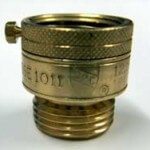 Vacuum breakers complicate things The problem with external vacuum breakers (aka backflow preventers) is that they don’t allow all of the water to drain out. After the water is turned off and appears to have drained out, the rubber seal in the vacuum breaker will still trap enough water to destroy the vacuum breaker, which will cause water to spray out all over the place when the faucet is used again in the spring.
Vacuum breakers complicate things The problem with external vacuum breakers (aka backflow preventers) is that they don’t allow all of the water to drain out. After the water is turned off and appears to have drained out, the rubber seal in the vacuum breaker will still trap enough water to destroy the vacuum breaker, which will cause water to spray out all over the place when the faucet is used again in the spring.
There are two possible solutions: remove the vacuum breaker in the fall, or drain the water out of the vacuum breaker. If the vacuum breaker will just unscrew from the sillcock, go ahead and take it off in the fall. The problem with this is that vacuum breakers are often designed to be permanently installed. They have a little set-screw on the side that gets tightened down until it breaks off, making it so the vacuum breaker can’t be removed. If your vacuum breaker leaks every time you turn on your faucet and you need to replace it, there is still a way to remove it without destroying your faucet – I made a video showing how to do it.
If the vacuum breaker can’t be removed or you don’t want to hassle with removing it, no problem; there is still a way to drain the rest of the water out. If you look up inside the vacuum breaker, you’ll notice that there is a small white plastic post. Just push this post to the side, and the rest of the water will drain out. The video below shows how this works.
If the vacuum breaker doesn’t have that white post, it may have a plastic ring that will allow it to drain.
What about those insulated faucet covers? I don’t trust ’em. They’re probably just a little better than nothing. Don’t waste your time.
POST UPDATE 11/25/14: Forgot to Winterize Your Outside Faucets? Here’s What to Do
Author: Reuben Saltzman, Structure Tech Home Inspections

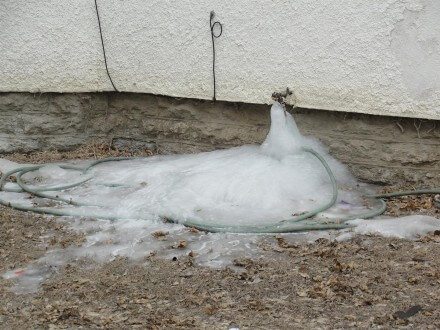
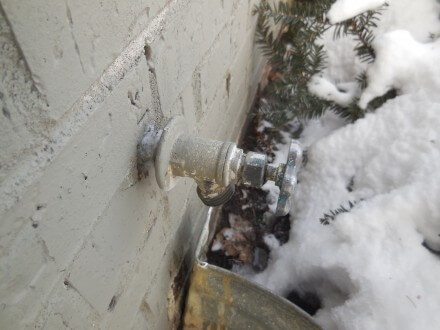
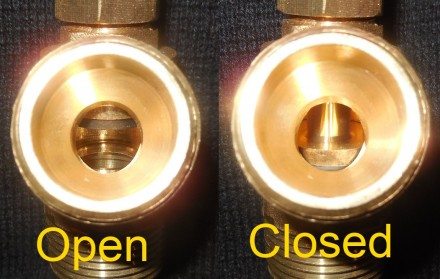


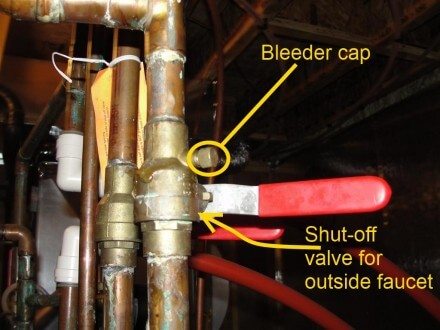
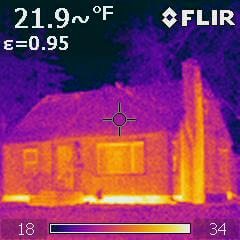
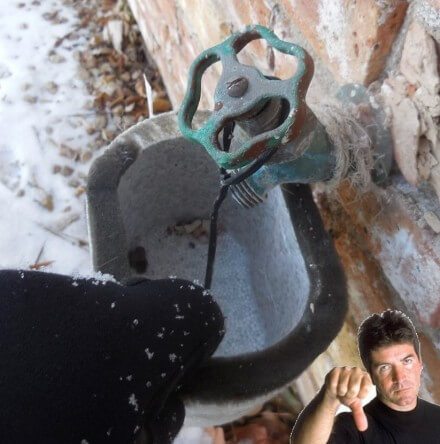
Reuben (not the inspector)
January 17, 2012, 9:04 am
Nice Post! There’s a lot of useful info here. A good question for sillcock manufactureres: Why isn’t the nailing flange automatically angled to make sure the sillcock is sloped the right direction?
Reuben Saltzman
January 17, 2012, 8:30 pm
Reuben- thanks. The next time you’re at your favorite home improvement store, check out the frost-free sillcocks. You’ll see that they come with a little plastic wedge that’s supposed to angle them down. I think your idea of making the flange angled is even better though.
Reuben Saltzman
January 17, 2012, 8:32 pm
By the way, there’s a photo of that shim in this post – http://activerain.com/blogsview/2415570/sweating-naked-and-frost-free-outside-faucets
Top 20 Home Inspection Photos from 2012 | Structure Tech Home Inspections
December 31, 2012, 4:02 am
[…] faucet – Frost free faucets have a long stem that allows the water to be turned off inside the home, preventing them from […]
Penny
January 25, 2013, 7:51 am
I did as you said turned off the outside water from inside then opened up the faucet outside waited for the water to stop dripping and now I can’t open it up again, should I leave the water inside shut off and stuff something in the open faucet on the outside. I am a female that is 69 and don’t have the strength to turn it, I think in that short time it froze. I live in PA and we have had freezing temps.
Reuben Saltzman
January 25, 2013, 3:09 pm
Hi Penny, pick up a garden hose cap and screw that on to the end of your faucet.
Cindy
February 17, 2013, 4:26 pm
We live in a townhouse in Blaine. Every year my husband winterizes the outside faucets and wraps them with a towel and duct tape. Apparently our association has hired a company to clean the snow off of the roofs and ice out of the gutters using steam. They have been going around asking people to turn their outside water on for them to use. Wouldn’t turning the water back on for them to use defeat the purpose of winterizing in the first place?
Reuben Saltzman
February 18, 2013, 5:02 am
Cindy – yes, it would. Hopefully you only have to have the faucet turned on for a short period of time.
Bathroom Faucets
April 8, 2013, 1:08 am
Let your faucets drip. This may help prevent freezing for a short time overnight.
Michelle
June 25, 2013, 6:19 am
I need to turn on an outside faucet that has not been used in a number of years (It was winterized when last used). Will I encounter any problems?
Reuben Saltzman
July 14, 2013, 12:54 pm
Michelle – possibly.
Becky
November 7, 2013, 1:06 pm
I think I have winterized my faucet but need to know if I leave the facet open outside or shut. I have turned off the water to the hose in the basement, unscrewed the hose from the bib and I drained the water. Do I close the lever or leave it open? Thanks so much.
Reuben Saltzman
November 7, 2013, 1:21 pm
@Becky – I’ve heard people make cases for both. It don’t think it makes any difference.
Becky
November 7, 2013, 1:40 pm
Thanks so much for your quick response!
Dorrie
November 7, 2013, 2:57 pm
Until what temperature can I leave the water on? We have had an awfully dry fall, and I want to water as long as the bushes and trees need it.
Reuben Saltzman
November 7, 2013, 2:59 pm
To be safe, shut off the water before outdoor temps reach freezing.
Jake T.
December 5, 2013, 1:06 pm
The outdoor spigot on my house was used about a month ago and I forgot to detach the hose. I just removed it this morning and there is ice up to the mouth of the spigot. I’ve never had problems before in much colder temps with freezing, even without turning off water from the inside. However, I’ve never left a hose on either. Did I doom my pipes to blow when temps get above freezing next week?
Reuben Saltzman
December 5, 2013, 1:19 pm
@Jake T – hopefully not. Put a hair dryer on the faucet for a half hour to thaw it, then test it out. If it works, you’re good to go.
Christi
December 8, 2013, 9:17 pm
If I have not already detached hoses, should I still do it? We hit freezing temps about a week ago.
Reuben Saltzman
December 9, 2013, 4:52 am
@Christi – yes, you should still detach the hoses.
Craig
December 13, 2013, 5:30 pm
Due to both of us thinking the other shut off the interior valves (front & back) we missed it. We won’t see above freezing until who knows. Now what…..leave the interior valves open or close them?
Reuben Saltzman
December 14, 2013, 5:48 am
@Craig – definitely close the interior valves. If you can get the exterior valves to open, that would also be a good thing to do. Just leave them open.
Jim
December 30, 2013, 12:58 pm
I have just installed a new Frostfree sillcock in my N. Ohio home. Before I seal up my working space in basement ceiling area, should I … Or does it benefit at ALL to put foam insulator on the sillcock pipe??
Thanks!
Reuben Saltzman
December 30, 2013, 1:45 pm
Yes, by all means, foam around the pipe where it penetrates the rim. That will help prevent air leakage. You shouldn’t need to insulate the pipe itself though.
Jim
December 30, 2013, 1:56 pm
I do understand sealing the air around the rim yes. I was just wondering if insulating the actual sillcock pipe itself was counter active?? I can’t imagine it would be, and it won’t cost me anything for I have left over foam insulator in garage LOL
Thanks Reuben
Phil
January 4, 2014, 9:24 pm
Great info.
Here’s my boneheaded story; it’s been -20c here all over the Xmas holidays and I decided to make my kids an outdoor rink, since freezing rain created a natural base….For 2 days I watered using outdoor faucet, would immediately detach the quick connect hose then roll it up and bring indoors. The 3rd day (night before went down to -35c) I can’t open the frost free spigot. I guess it was so cold and the smaller quick connect nozzle trapped water in the faucet to instantly freeze…Using 2 kettles of hot water I slowly thawed it, but on opening I heard water flow but none came out. I knew what happened and glad the frost free faucet burst in the pipe not my pex water line (so no flooding, just a couple cups of water indoors). Now off to buy another one but it’s a rented house, so owner isn’t pleased I had to cut a hole in his finished basement ceiling and no sign of main water valve…until I find it I will wrap the split section in jb waterweld as a precaution and condemn it…plus since then found an indoor sink to use for rink watering, hot water to boot!
Jennifer
January 5, 2014, 12:11 pm
I’ve lived in my townhome for 4 years and winterize the outside faucet every fall by shutting off the water valve inside the house, opening up the outside faucet, and removing the bleeder cap inside the house to completely drain the line. I haven’t noticed this in previous years….but recently found the bleeder cap has a slow drip coming from it (I had loosely screwed the cap back on after letting all the water drain out). I’ve double checked the shut off valve is all the way off and there isn’t any ice or water coming out of the outside faucet. Is this slow drip something to worry about? Is there anything else I can check/do? thanks!
Reuben Saltzman
January 7, 2014, 4:49 am
@Jennifer – it sounds like you need a new shut off valve. That slow drip could be filling the pipe back up with water, and the slow drip will get worse over time.
christy
January 6, 2014, 8:40 pm
I can’t seem to get the interior shut off valve to move to shut off water to the outside faucet. Tonight will coldest night here in a decade. Should I shut off water to the entire house for the night?
Reuben Saltzman
January 7, 2014, 4:58 am
@christy – shutting off the water to your house could save you from major water damage if your pipe bursts during the night. It wouldn’t prevent the pipe from bursting, however. It couldn’t hurt to shut the water off.
Al Remouga
February 5, 2014, 8:14 pm
I just noticed that I did not detach the hose from my the outdoor faucet and now with freezing temps there a block of ice around the faucet. Has the pipe already broken? I don’t have a shut off for just this faucet but for the whole house. What should I do?
Reuben Saltzman
February 6, 2014, 5:39 am
@Al – is the pipe broken? Maybe. Get a hair dryer and thaw the ice around the faucet so you can at least remove the garden hose. Also, have a plumber install a shutoff valve inside the house if it’s not a frost-free faucet.
Chris Chaney
February 7, 2014, 6:28 pm
I live in a house that is 100 years old. I have never had pipes burst. I noticed that there is a “waterfall” of ice around my front yard faucet. The hose was not connected. Does that mean that a pipe has burst and what will happen when the ice around the faucet finally melts? I cannot find a valve in the basement on the ceiling or anywhere else to turn the water to the outside off. Should I call a plumber right away? I am afraid as soon as the ice melts something really bad is going to happen. Help!
Chris Chaney
February 7, 2014, 6:29 pm
Correction…the hose WAS disconnected back in the fall.
Reuben Saltzman
February 8, 2014, 6:21 am
@Chris – yes, you should call a plumber right away.
jane smith
February 20, 2014, 1:50 pm
Please tell me how a connected hose could possibly cause a pipe to freeze. If the hose is positioned downward, wouldn’t the water flow down and out, away from the connection?
Reuben Saltzman
February 20, 2014, 1:54 pm
@jane – if there is a spray head attached to the hose, all of the water in the hose will still be trapped.
If the hose has loops that create traps, water in the hose will freeze and prevent water from draining out.
Michelle
February 27, 2014, 12:09 pm
Reuben, thanks for this awesome info. I have a question: it is a high of -2* today and won’t get above 17* for the high in the next 5-6 days here in Mpls (as you know). We mistakenly did NOT turn off our interior valve to the exterior spigots, nor open up said exterior spigots this fall like usual. I’d like to do this now to prevent pipe freezing/bursting, but am nervous about doing it in such extremely cold temperatures.
Is there any downside to doing it in these temps? If so, what temperature do we need to hit to do this with less risk? Since above freezing temps won’t come for a while, I’m living with a big fear of bursting pipes right now.
We live in a 1972 rambler with 2-3 spigots to the exterior, all controlled by one interior valve.
THANK YOU!!!
Reuben Saltzman
February 27, 2014, 3:34 pm
Hi Michelle, I can’t think of any potential risk in winterizing your faucets now. Given the fact that they’re all frozen, you’ll probably need to thaw each one with a hair dryer or heat gun first.
Emily
March 2, 2014, 5:07 pm
We forgot to remove our two hoses. We did turn the exterior water supply out in the fall. We just noticed a small drip on one of the pipes in inside the house. What should we do? Remove the hose with hot water? And call a plumber? So scared the pipe burst and will cost an arm and a leg to fix.
Reuben Saltzman
March 2, 2014, 8:23 pm
@Emily – yes, remove the hose; try a hair dryer to warm it up at the exterior if needed.
Try to figure out where the drip came from. Can you see the pipe split? Keep the water supply off until it warms up. Once it’s warm turn on the water supply slowly and watch where the drip came from to make sure nothing happens. If something starts to leak, shut the water back off right away and contact a plumber to fix it.
Matt
March 2, 2014, 9:23 pm
Hey Reuben, we live on Oklahoma, and the temperatures today dropped to 10 with a -10 windchill. We have a 2-year old house with a slab foundation. I checked the outside spigots today and saw that the hoses were still attached. I detached the hoses (came off easily) and tried to turn on the water at both spigots. Nothing came out, however, there was no visible ice around the spigots either. I immediately turned the valves closed again. I covered the spigots with socks, foam, and plastic bags. We have no shutoff valve just for the exterior spigots, and it will not be above freezing again for two more days. The spigots appear to have some kind of extension that connects to the hose. Is there anything else I should do right now? Thanks!
Reuben Saltzman
March 3, 2014, 4:36 am
If you don’t have a shutoff inside the house, you’ll just have to keep your fingers crossed. Hopefully you’ll lose enough heat from the house to prevent damage to the faucets.
jannie
March 6, 2014, 12:50 pm
Can your valves open or close on pre- set temperatures
Thanks
Jannie
Reuben Saltzman
March 7, 2014, 5:15 am
@jannie – not that I’m aware of.
cab
March 11, 2014, 8:56 am
I have a well and a hydrant. I hooked up a hose a week ago so I could water my horse, and didn’t remove the hose. I shut the hydrant off. Now it’s warmer (going to 50 degrees today), but I can’t budge the handle on the hydrant.
I’m not forcing it. If I just wait, will it be okay? We are supposed to be getting at least another week of on and off freezing, going up and down from thaw to freeze.
Reuben Saltzman
March 11, 2014, 11:17 am
@cab – probably.
cab
March 11, 2014, 12:32 pm
I read on the Net to pile charcoal briquets around the hydrant pipe, burn them, and cover with foil to direct the heat down. I did that, and pretty soon the water was boiling and steam coming out the spigot, and it’s still cooking. It’s 50 degrees today also. I wanted to be sure the ice melted before the next cold spell hit. Well, it’s melted. I’m not sure how far down the frozen water goes. I’m leaving it to “bake” and hope it won’t melt anything important (rubber or plastic). The handle comes up now, and I let a little water out and then shut it quick.
Elizabeth
March 12, 2014, 2:05 pm
We have a frost-free hose bib on an outside wall. With the extreme cold in Chicago last month, the copper pipe feeding the hose bib burst and flooded our first floor and basement. The copper pipe burst just below where it attached to the hose bib, above ground level. The pipe is near the drywall and surrounded by insulation. We’ve owned the house for two winters, the first of which was mild. As part of renovations, we added the frost free hose bib. Is there any chance that adding the frost free hose bib made our situation worse? Or is the fault entirely due to the cold permeating the exterior brick and freezing the copper pipe? (No hose attached.) Thank you.
Reuben Saltzman
March 13, 2014, 12:29 pm
@Elizabeth – no, adding the frost free hose bib wouldn’t make your situation worse unless it was installed improperly or the insulation was moved away and never replaced.
Installing a frost-free hose bib would not negate the need for a shut-off valve inside the house, according to Minnesota State Plumbing Code. I don’t know the rules in Chicago. Either way, it’s still wise to have a separate valve.
Elizabeth
March 13, 2014, 12:16 pm
A related question: Would installing the frost-free hose bib negate the need for a shut-off valve in the basement? Thanks for your help.
Rus Hollister
March 21, 2014, 9:44 am
I have faucet that comes out of my basement, travels on the bottom of my porch until it fastens to the outside surface of my porch. 6 Feet from the inside of my basement wall to the faucet, all above ground. We normally drain the faucet and pipe, but this year we had a hard early freeze and I couldn’t get the faucet open to drain, actually the valve stem sheared off when I tried to open it. Does anyone make a frost-free faucet that would be long enough to use here?
Reuben Saltzman
March 21, 2014, 10:04 am
@Rus – as far as I know, no. I think the longest I’ve seen is 18″.
Dave
March 29, 2014, 12:22 pm
Reuben-
Thanks for writing this article as it has given me some of the education that I need. I have a frost-free silcock and can not really tell if the pitch is correct. I just turned it on for the first time in the spring and the cap on top popped off and the plastic piece under the cap is broken. I am thinking that freezing happened inside it and may have broken the cap, but that is an uneducated guess. If I hook a hose up, water flows out of the broken cap rather than the faucet. Do you think this means that I may have a pipe burst or do I likely just need to replace the cap? I am worried that water will end up inside my house if I use it while troubleshooting. I do not have good inside access to see if from the back. Thank You.
Reuben Saltzman
March 31, 2014, 7:44 pm
@Dave – I’m quite certain the cap is just there to prevent debris from getting inside. If you have water coming out of the cap, you probably just need to replace the faucet.
Ross
March 31, 2014, 7:05 pm
Thanks you for the video on how to remove the vacuum breaker faucet. The issue that I am having is that the vacuum breaker set screw is broken off below the level of the outside brass. So more than likely I will have to drill it out. When I try to unscrew it counter clockwise it just turns. Clockwise it will just tighten and stop. This is a hot/cold faucet inside my heated garage. It breaker part drips and leaks. It also spray water everywhere if I forget to release pressure at the hose end before turning the water of. Thanks for any advice you can give me. I live in ND, so I am sure this type of thing is code.
Reuben Saltzman
March 31, 2014, 7:40 pm
@Ross – It sounds like you’ll need to try cutting the whole thing off. I’m guessing you’ll end up destroying the faucet in the process; if so, replace the faucet.
Lindsi
April 6, 2014, 10:53 pm
hello, i had my bleeder cap thingy off for the winter, drained the pipes and all… but now i try to turn the water back on and it shoots out the screwed on cap..is there supposed to be a hole in it??? wtf? 🙂 what do i do?
Lindsi
April 6, 2014, 10:55 pm
hello, i had my bleeder cap thingy off for the winter, drained the pipes and all… but now i try to turn the water back on and it shoots out the screwed on cap..is there supposed to be a hole in it??? wtf? 🙂 what do i do? eek.
Reuben Saltzman
April 7, 2014, 3:53 am
@Lindsi – the bleeder cap should have a tiny little rubber gasket / washer inside it. If that’s missing, it will definitely leak. Go to a hardware / home improvement store and check out their shutoff valves with drains built in to see a sample and get a new one.
Belinda Danies
April 10, 2014, 8:21 pm
Hello,
I winterized the front porch water spigot. When I turn on the water from the inside of the garage; I can hear the water but no water in the front porch. I replaced the stem (Legend Valve T-550) thinking it got damaged during the winter and still no water comes out when I turn the main water to the porch. What do think is the problem?
Reuben Saltzman
April 11, 2014, 3:47 am
@Belinda – I’m guessing a copper tube separated at one of the soldered joints somewhere inside the wall. How long did you leave the water on for? If water is leaking somewhere inside the wall or ceiling, would you see it right away?
L R Smith
April 22, 2014, 3:08 pm
What can you put on threads of spigot to keep adapters and hoses from sticking/rusting. WD40/Liquid wrench is not helping. I just spent 4 hours breaking pastiic thumb ring off and then sawing chiseling metal ring off. Before I start again can I put grease/vaseoline on threads? Help.